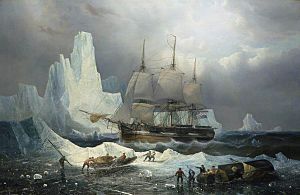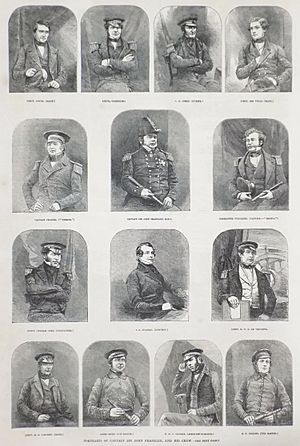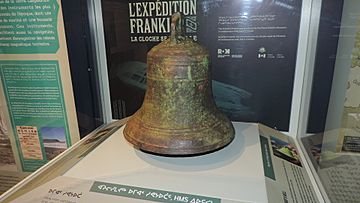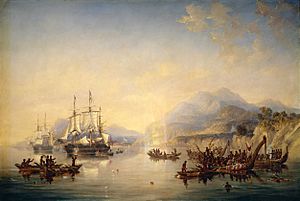HMS Erebus (1826) facts for kids

Erebus in the Ice, 1846, by François Musin
|
|
Quick facts for kids History |
|
|---|---|
| Name | HMS Erebus |
| Namesake | Erebus |
| Ordered | 9 January 1823 |
| Builder | Pembroke Dock, Wales |
| Laid down | October 1824 |
| Launched | 7 June 1826 |
| Fate | Abandoned 22 April 1848, King William Island |
| Wreck discovered | 2 September 2014, Wilmot and Crampton Bay |
| General characteristics | |
| Type | Hecla-class bomb vessel |
| Displacement | 715.3 long tons (727 t) |
| Tons burthen | 372 tons (bm) |
| Length | 105 ft (32 m) |
| Beam | 29 ft (8.84 m) |
| Installed power | 30 Nominal horsepower |
| Propulsion | Sail, steam engine |
| Complement | 67 |
| Armament | |
| Official name: Wrecks of HMS Erebus and HMS Terror National Historic Site | |
| Designated: | 2019 |
HMS Erebus was a special type of ship called a bomb vessel, built by the Royal Navy in Wales in 1826. It was the second ship in the Royal Navy to be named after Erebus, who was the god of darkness in Greek mythology.
This 372-ton ship was armed with two large mortars and 10 guns. Erebus became famous for its role in two important expeditions. First, it explored Antarctica from 1839 to 1843. Later, it was abandoned in 1848 during the Franklin expedition in the Arctic. The ship's sunken wreck was found by a Canadian team in September 2014.
Contents
Exploring Antarctica: The Ross Expedition
After serving for two years in the Mediterranean Sea, Erebus was prepared for an exciting journey to Antarctica. On November 21, 1840, with James Clark Ross as its captain, it sailed from Van Diemen's Land (which is now Tasmania). It traveled alongside another ship, HMS Terror.
In January 1841, the crews of both ships landed on Victoria Land. They named different parts of the land after important British people. For example, Mount Erebus was named after Erebus, and Mount Terror was named after the other ship.
The crew then found the huge Ross Ice Shelf, which was a giant wall of ice they couldn't get through. They followed it eastward until the season became too late, and they had to return to Van Diemen's Land. The next year, in 1842, Ross continued to explore this "Great Ice Barrier."
Both ships went back to the Falkland Islands before returning to Antarctica in 1842–1843. They studied magnetism and collected information about the ocean, as well as different plants and birds. The plants they found were described in a book called The Botany of the Antarctic Voyage of H.M. Discovery Ships Erebus and Terror. The birds were described in another book, The Zoology of the Voyage of HMS Erebus & HMS Terror. Birds of New Zealand. A young botanist named Joseph Dalton Hooker was also part of this amazing journey.
The Lost Franklin Expedition

On May 19, 1845, HMS Erebus and HMS Terror began a new adventure. They left Greenhithe, England, to explore the Canadian Arctic. Sir John Franklin was in charge of the expedition, sailing on Erebus. Francis Crozier commanded Terror.
Both ships had steam engines, which were taken from old steam locomotives. The engine on Erebus could make the ship move at about 4 knots (7.4 km/h). The ships also had strong iron plating added to their hulls to help them in the ice.
The expedition's main goals were to collect magnetic data in the Canadian Arctic and to find a way through the Northwest Passage. This passage was a sea route that connected the Atlantic and Pacific oceans through the Arctic. Parts of it had been explored, but no one had ever sailed all the way through.
The ships were last seen by other Europeans in August 1845, entering Baffin Bay. After that, they disappeared. This led to a huge search effort in the Arctic. The first clues about what happened came in 1853, when a doctor named John Rae talked to local Inuit people. Later expeditions confirmed these reports.

Both ships became stuck in the ice and were abandoned by their crews, about 130 men in total. All the men died while trying to walk south. They faced many challenges, including cold, scurvy (a disease from lack of vitamin C), and starvation. Later studies also suggested that the ships' canned food might have been bad, possibly causing lead or botulism.
In April 1851, another ship saw two abandoned ships on a large ice floe near Newfoundland. People thought these might be Erebus and Terror, but it was later confirmed they were likely other abandoned ships.
Discovery of the Wreckage
On August 15, 2008, Parks Canada, a Canadian government agency, announced a search for the lost ships. The goal was to find them and strengthen Canada's claims over parts of the Arctic. The search was led by underwater archeologist Robert Grenier and local historian Louie Kamookak. Kamookak had collected many stories from the Inuit people about the wreck. He was later honored for his important work.

The wreckage of one of Franklin's ships was found on September 2, 2014, by a Parks Canada team. On October 1, 2014, it was announced that the ship found was Erebus. A month later, on November 6, 2014, they announced that the ship's bell had been found. Divers from Parks Canada and the Royal Canadian Navy began exploring Erebus in April 2015.
The exact location of the wreck is kept secret to protect it. However, a special area in Wilmot and Crampton Bay has restricted access. On September 12, 2016, the wreck of HMS Terror was also found in Terror Bay. Both wrecks are now recognized as National Historic Sites. In October 2017, the United Kingdom agreed to give ownership of both ships to Canada and the Inuit, keeping only a few items and any gold found.
In September 2018, Parks Canada reported that Erebus had been damaged. A large section of its upper deck had broken off and moved. This was likely due to strong waves in the shallow water. In 2019, Parks Canada recovered many personal items from Erebus, which were shown to the public in February 2020. Plans for more exploration in 2020 were canceled because of the COVID-19 pandemic.
The Parks Canada Underwater Archaeology Team returned to the wrecks in May 2022. They found 275 items from Erebus, including a leather-bound book in the steward's pantry. They hope that finding more written materials will help them learn more about the expedition.
Visiting the Wreck Site
On September 5, 2019, passengers on the ship MS Ocean Endeavour were the first members of the public to visit the Erebus wreck site. The site is part of the Wrecks of HMS Erebus and HMS Terror National Historic Site. It is managed by Parks Canada and local Inuit people. Public access is usually not allowed, but this visit was a test to see if a visitor experience could be created for the site.
Legacy of Erebus

The story of HMS Erebus and the Franklin expedition has inspired many works of art, entertainment, and media.
In Books, Movies, and Music
- Erebus and Terror are mentioned in Jules Verne's book Twenty Thousand Leagues Under the Seas (1870).
- They also appear in Joseph Conrad's story Heart of Darkness (1899).
- Terror and Erebus (1965) is a radio play by Canadian poet Gwendolyn MacEwen.
- Terror and Erebus (A Lament for Franklin) (1997) is a musical piece inspired by MacEwen's play.
- Ice Blink: The Tragic Fate of Sir John Franklin's Lost Polar Expedition (2001) tells the story of the expedition.
- Dan Simmons' novel The Terror (2007) is a fictional story about the expedition.
- This book was made into a TV series called The Terror in 2018.
- Clive Cussler's novel Arctic Drift (2008) uses the ships in its plot.
- "Erebus" (2012) is a radio play by British poet Jo Shapcott.
- Erebus: The Story of a Ship (2018) by Michael Palin tells the ship's entire story.
- "Erebus and Terror" is a song by the Canadian folk band Nickeltree (2016).
- "The Erebus and the Terror" is an instrumental song by Nightnoise (1987).
- "Erebus and Terror" is also a song by the Welsh band Hecate Enthroned (2019).
Places Named After Erebus
- Mount Erebus: A large volcano in Antarctica, named after the ship. It's the second-highest volcano in Antarctica.
- Erebus Bay: A bay in Antarctica, near Ross Island.
- Erebus and Terror Gulf: A gulf in Antarctica, named after both ships.
- Erebus crystal: A type of feldspar crystal found near Mount Erebus.
- Erebus (crater): A crater on the planet Mars, named after HMS Erebus. The Opportunity rover visited it.
- Erebus Street: A street in Keilor Park, Melbourne, Australia.
Images for kids
-
Officers of Erebus and Terror in 1845. Sketches from photos by Richard Beard.
-
Model of Erebus trapped in the ice, Nattilik Heritage Centre, Gjoa Haven, September 2019
-
Ship's bell from HMS Erebus, dated 1845, at the Nattilik Heritage Centre, Gjoa Haven, 2019
-
Canadian Prime Minister Stephen Harper at a celebration for the discovery of HMS Erebus at the Royal Ontario Museum in Toronto.
See also
 In Spanish: HMS Erebus (1826) para niños
In Spanish: HMS Erebus (1826) para niños
- European and American voyages of scientific exploration










